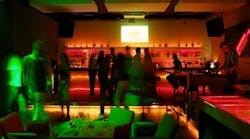Shortly after 11pm on Thursday, February 20, 2003 a fire at the Station Nightclub in West Warwick, Rhode Island left 100 dead and many more injured. This fire, which occurred 10 years ago, was one of the deadliest nightclub fires in the history of the United States.
“Inadequate fire protection features were a major contributing factor to the significant number of deaths and injuries,” says Chris Jelenewicz, Engineering Program Manager with the Bethesda, Maryland-Based Society of Fire Protection Engineers. “It’s uncanny how almost 10 years later we saw similar fire protection flaws at a Brazilian nightclub where over 230 died.”
The Station Nightclub was a one-story, wood frame building that regularly hosted live band performances. The fire started on stage while a rock band was playing.
Fire investigators determined the fire started when pyrotechnics used during the band’s performance ignited polyurethane foam that lined parts of the nightclub’s walls and ceilings. After ignition, the fire spread quickly along the ceiling and throughout the building. Within seconds, conditions in the building became deadly and flames were observed breaking through the roof in less than five minutes after the fire started.
Over 440 people occupied the building at the time of the fire. Most of the occupants tried to exit through the main front doorway. This doorway quickly became jammed with occupants trying to exit the building.
The building was not equipped with an automatic fire sprinkler system.
“Because the fire and smoke spread so quickly and the building was not equipped with a fire suppression system, the building occupants just didn’t have enough time to get out alive,” says Jelenewicz.
As a result of this fire, many building requirements were enhanced to make nightclubs safer from fire. Some of these requirements included provisions for automatic fire sprinklers in new and existing nightclubs and a requirement to have crowd managers present to assist with emergency building evacuations.
The Station Nightclub fire investigation was performed using cutting-edge fire protection engineering tools. After the station nightclub fire, fire protection engineers used computer fire models along with full scale fire tests to analyze how the fire spread through the building. Additional information about this investigation can be found in Fire Protection Engineering magazine at http://magazine.sfpe.org/fire-modeling/nist-station-nightclub-fire-investigation-physical-simulation-fire.
On January 27, 2013 a nightclub fire in Santa Maria, Brazil left over 230 dead. Similar circumstances such as overcrowding, inadequate building exits, indoor pyrotechnics, flammable wall finish and a lack of fire suppression systems played a role in the high number of deaths.
“The Station Nightclub Fire and the recent nightclub fire that occurred in Brazil remind us of the threat that is posed by fire and the importance of designing buildings that that keep people safe from fire,” says Jelenewicz.
Jelenewicz cautions that despite the fact that fire protection engineers are working hard to improve nightclub fire safety, it’s important to remain vigilant when you enter a nightclub. He offers these fire safety tips.
- Situational awareness is important. That is, know and understand what is happening around you.
- Your senses can alert you that a fire or other building emergency is occurring in the building. If you hear the building’s fire alarm/emergency communication system or people screaming, see smoke or fire, and/or smell smoke evacuate the building immediately.
- When you enter a nightclub look for an alternate way to evacuate the building if an emergency occurs. When fires do occur in nightclubs, occupants tend to evacuate by the same way they came into the building. This often causes a condition where the exit doors become jammed and unusable. So knowing an alternative means to evacuate could save your live.
- If the nightclub appears to be so overcrowded that you feel uncomfortable leave the building immediately.
- During building emergencies always follow the directions that are given by the building’s emergency notification system and/or the building staff.


